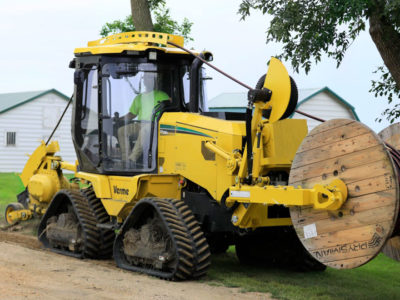With more and more people working from home, the need for fiber connections and bigger broadband is being felt across the country. This move to fiberoptic infrastructure isn’t slowing down and is providing business and employment opportunities in a time where labor is highly coveted. According to BroadbandNow, 32% of the nation has access to fiber.
As organizations work on connecting homes and cities with fiber, there are a variety of ways they can accomplish it. For each method, Vermeer has equipment that can get the job done. This is important work, whether you end up drilling, plowing or microtrenching in fiber cables. Let’s dive into each one of those methods to get a closer look at the Vermeer equipment and where they’re used in the installation process.
Horizontal directional drill
A common way to install conduit and fiber is with a horizontal directional drill. In rural areas, larger drills, like the Vermeer 24×40 S3 HDD and above, are usually what is used along rivers or highway crossings.
“When it comes to urban installations, smaller drills are what you usually see,” explained Clint Recker, Vermeer product manager. “That means a Vermeer D10x15 S3 HDD or D20x22 S3 HDD, basically any drill that’s 24,000 pounds (10,900 kg) or less.” These smaller drills are used to install lines along streets or in neighborhoods.
Plow
Many operations choose to plow their fiber lines instead of drilling them, or in addition to drilling. Take Pella Fiber and Excel Utility Contractors. They’ve drilled the conduit in with Vermeer HDDs, and when it came to the drop installations, they plowed the conduit in too. Using Vermeer plows, like the PTX40 plow/trencher, they connected houses and businesses to the Pella Fiber network.
“In rural areas and in longer runs in the city, tractors like the Vermeer RTX450 and RTX750 ride-on tractors are used to plow,” said Ed Savage, Vermeer product manager.
When it comes to the city and urban environments, smaller plows, like the Vermeer SPX25 vibratory plow or the PTX40 plow/trencher are more common.
Microtrench
Another method that’s becoming increasingly common is microtrenching. Microtrenching is a technique where a very narrow trench is cut into the street surface — usually close to the seam — where the road meets the curb. Once the line is laid, a grout or epoxy compound is used to fill in the trench. The seam is then sealed, which helps protect the line while restoring the integrity of the road surface. This technique can be done by using a ride-on tractor (like the Vermeer RTX550 ride-on tractor).
These methods work well on fiberoptic or small conduit jobs because they can be cost-effective and can take less time than other installation methods.
“In many cities, the underground right-of-way is becoming crowded,” Savage said. “Microtrenching allows contractors to work where there might be fewer existing utilities and future repairs to damaged lines can be easier to access.
Vacuum excavation equipment
With the microtrenching method, you’ll need a vac system to remove the spoil from the trench.
You’ll want to choose a vac system that has at least 900 cubic feet per minute (25.5 m3/min). Typically, this will be a trailer vac, like the Vermeer LP SGT vacuum excavator, which has 1,000 cubic feet per minute (1,699 m3/hr).
For drilling, either a trailer vac or a truck vac can help you get the job done, like the Vermeer VXT300 vacuum excavator. This vac system is utilized for potholing or exposing existing utilities.
You should also keep in mind how far away your dumpsite is. If you have to haul the spoil a long distance, think about upgrading to a bigger spoil tank to lessen the number of trips to the dumpsite.
Utility locators
One last consideration for installing fiber is to make sure you know where other utility lines are located on the jobsite. To do that, you can use a utility locator. Before you use a locator, an important (and sometimes required) step is to call 811. All you have to do is call the national phone number and inform the operator where you intend to dig. That information is then routed to the local One Call center, and utility companies will typically send technicians out to mark underground utilities within a couple days. Even if a technician comes out and marks the underground utilities, using a utility locator can help locate the utility before exposing the utility line.
The Vermeer Verifier® G3 utility locator can help you correctly assess where the lines are and help avoid utility strikes or near misses.
No matter how you plan to install fiber lines, there is a Vermeer machine that can help you get the job done efficiently and productively. For more information about our fiber equipment lineup, contact your local Vermeer dealer.
Vermeer Corporation and Vermeer MV Solutions, Inc. reserve the right to make changes in engineering, design and specifications; add improvements; or discontinue manufacturing at any time without notice or obligation.
Equipment shown is for illustrative purposes only and may display optional accessories or components specific to their global region. Please contact your local Vermeer dealer for more information on machine specifications.
Vermeer, the Vermeer logo and Verifier are trademarks of Vermeer Manufacturing Company in the U.S. and/or other countries. © 2021 Vermeer Corporation. All Rights Reserved.
